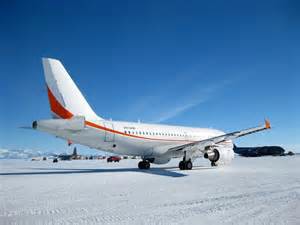I've spent 6 summers in Antarctica (Mt. Erebus), travelling through McMurdo, where the busiest airstrips on the continent are. Most flights to McMurdo are on C-17s or C-130 Hercules. Some of the Hercules are LC-130 -- the L indicates that they have skis. The skis enable them to land and take off on some including ungroomed or poorly groomed snow / ice surfaces. Sometimes they need JATO for takeoff, though, if the conditions aren't great.
McMurdo has three runways which open and close operations during the year: Willy Field, Pegasus, and the Ice Runway. The Ice Runway is on sea ice and the other two are on the Ross Ice Shelf with Pegasus built on blue ice and Willy Field on snow. The Ice Runway breaks up each year during the height of the summer so it is carefully monitored. It bends downwards each time a C-17 lands. That deformation is measured and is one of the parameters that's used to decide when to stop using the Ice Runway each year.
Sometimes, planes designed for non-military use are flown to McMurdo; the New Zealand Antarctic program often flies an Airbus A319 there. As far as I know, a well-groomed snow / ice runway can accommodate any plane in good weather. A Boeing 757 flight to McMurdo from Christchurch had a scary incident recently where it was forced to land in low visibility because it didn't have enough fuel to "boomerang" back to New Zealand. The C-17s often boomerang due to bad weather. The Hercules, like the 757, don't carry enough fuel to boomerang, but they are better at landing in inclement conditions so it doesn't seem to be an issue.
For flights within-continent, Twin Otters and Baslers are in common use.
No, there's no military presence with offensive capability. I don't really understand this (recently added) part of the question -- did you think they'd hit you with antiaircraft??? There's a bunch of air force guys who operate the flights, and a single US Marshall in McMurdo.


